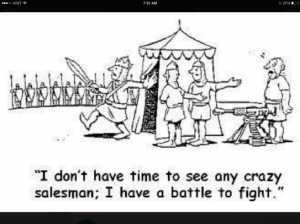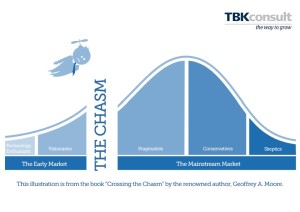The Dumb Customer or the Unfortunate Salesman?
It is easy to jump to the conclusion that potential customers that don’t get it must be “ignorant.” However, blaming our failing sales strategy on the customers may prevent us from making the changes that could overcome the resistance.
Look in the mirror. That is where all changes must start.

This picture has been posted on LinkedIn several times over the last few years.
The context has always been that “sometimes corporate executives are so busy (or ignorant) that they do not take the time to consider new solutions that could improve their situations dramatically.”
When I saw the cartoon the first time I also thought that the King must be daft. However, when I thought twice about it I changed my mind.
The machine gun salesman had apparently talked to the King’s people. He had apparently convinced the King’s people that he had something of interest. However, the King’s people were not able to convey the value of the machine gun to the King. At least not to the extent that the King is prepared to take a time-out now and listen to the value proposition.
Is this situation unusual?
Not at all. This happens each and every day all over the world in the year 2019 and it will continue as such forever.
The King needs a victory

The machine gun salesman is trying to sell the King a product today. The King needs a victory today. The enemy is lining up on the battlefield. The King has to fight now. He cannot cancel the battle and call the enemy when he is ready.
This difference in terminology and mindset between sales people and customer executives is common.
Sales people speak a language that makes customer executives fall asleep or that fails to catch their interest. Sales people peddle a product, but ignore all the training and implementation issues associated with making the product deliver value. Executives want something that works when they need it. They want to have the full RoI analysis and risk assessment before making a critical investment decision.
Making machine guns that win battles is about much more than just buying the hardware.
Crossing the chasm

I have come to the conclusion that the King is the King (we can’t change him, we can’t remove him, we must learn to deal with him or we must avoid him). So we may have the wrong sales strategy in the first place (is the King an early innovator?). We may have the wrong salesman assigned to the account (is today the best time for a sales call?).
We have a killer app (sorry!!), but we apparently need to navigate the King’s buying journey in a different way.
In the software industry, where I operate, our products are invisible. Imagine being a salesman with an invisible product. Imagine selling something that is invisible AND that the customer has never heard of before. Something that is also truly disruptive.
This situation is well documented by Geoffrey Moore in his book “Crossing the Chasm.“
There are approaches for overcoming such obstacles. I agree that these approaches were not available when the King was king, but they are available today.
Don’t blame the customer – blame yourself
As sales people we get to know a lot about the domain area in which we operate. Often we get to know much more than our potential customers. As we refine our sales pitch and win new customers we get frustrated when potential customers “don’t get it.”
How come some customers get it and others don’t?
It is easy to jump to the conclusion that potential customers that don’t get it must be “daft.” However, blaming our failing sales strategy on the customers may prevent us from making the changes that could overcome the resistance.
Look in the mirror. That’s where the answers are.








